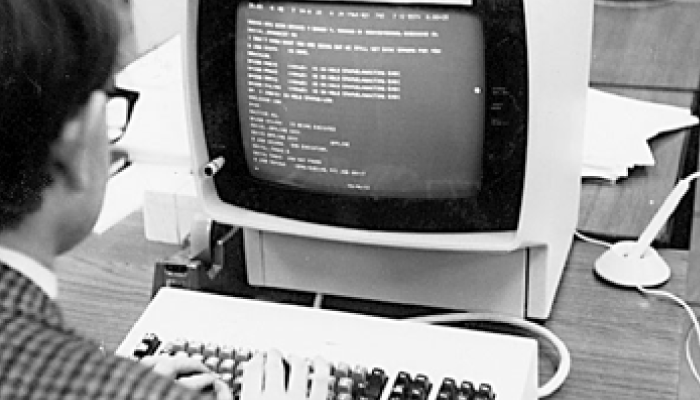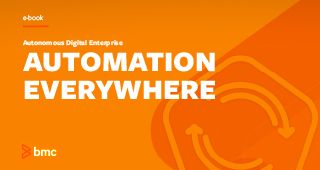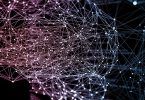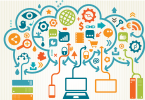An industrial revolution is upon us. In fact, it’s the fourth time an industrial revolution has occurred. This time, it’s driving digital transformation trends and helping companies become Autonomous Digital Enterprises.
In this article, we’ll:
- Define the fourth industrial revolution
- See how we got this far
- Look at the 4 key design principles
- Share trends so you can stay ahead of the competition
What is the Fourth Industrial Revolution?
The Fourth Industrial Revolution is the automation of manufacturing and industrial practices that would otherwise be manual tasks.
Modern intelligent technology, machine communication in large machine-to-machine networks, and the advent of the Internet of Things (IoT) combine to create opportunities for businesses to capitalize on:
- Smarter automation
- More detailed communication and advanced self-monitoring
- The creation of intelligent machines that manage, monitor and maintain systems
- Solving problems without the need for developers
A brief history of the Fourth Industrial Revolution
In 2015 Klaus Schwab, executive chairman of the World Economic Forum, coined the term “fourth industrial revolution”. In 2016, the Forum began to study the fourth industrial revolution at a center in San Francisco. Schwab sums up this revolution as:
This is the era of autonomous vehicles and other breakthroughs in automation that streamline efficiencies for business through robotics and intelligent automation mixed with quantum computing and biotechnology.
As the name suggests, there have been three preceding industrial revolutions:
- The first industrial revolution transitioned from hand-building techniques to steam power occurred roughly between 1760-1840.
- In the late 19th and early 20th centuries, railroads and mail service emerged.
- At the end of the 20th century, a third industrial revolution ushered in an era of digital technology.
This third revolution, the digital era, happened as a decades-long response to World War II and the resulting industrialization slowdown. In time, computers and hand-held technology came to dominate the marketplace and business ecosystem, particularly around the need for more efficient ways of communication.
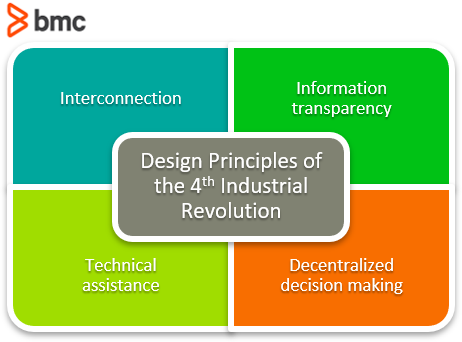
What is Industry 4.0?
You might also hear about Industry 4.0. The term Industry 4.0 refers to the German government’s complex, high-level strategy to promote digitization and computerization in traditionally human industries. For instance, in manufacturing, human operator error can cause accidents or damage thousands of dollars of equipment.
Industry 4.0 has four design principles:
- Interconnection
- Information transparency
- Decentralized decision making
- Technical assistance
Technologies of the 4th Industrial Revolution
These popular concepts and technologies are what we mean when we talk about this 4th industrial revolution. You’ll see—with these technologies vast potential—why this revolution is playfully dubbed “the imagination age”.
Virtual reality (VR)
This emerging technology allows corporations to create immersive experiences using a digital VR headset. This can be anything, for instance:
- Virtual safety training for employees in the transportation industry.
- Virtual vacation services in the travel industry that help people take a staycation that feels more luxurious than just staying home.
These immersive digital experiences are designed to simulate real-world experiences, sometimes with augmented perceptions that allow the user to react, respond, and learn from the simulation.
Smart computing and automation
Computing software today is designed for enterprise software needs. It can collect, organize, and assemble large chunks of data, provide visualizations, and even assist in practices like:
- Development
- Monitoring
- Virtual assistant functions
3D printing
3D print makes physical tooling more accessible. This physical tooling—“printers”—can help quickly develop and deploy creative ideas into the marketplace:
- Large-scale 3D printing has the potential to create medical devices and healthcare tools quicker and more affordably than traditional manufacturing.
- At-home 3D printing has also come far, with hobbyists experimenting with print-at-home car parts, shoes, and more!
With the development of 3D printing, fields from medicine and science to engineering and robotics can be decentralized. This means tools can be created as needed, more affordably, and closer to the source than even before.
Renewable energy
This technology is relatively new within this 4th revolution. Today’s scientists and engineers look for ways to capitalize on decreasing renewable energy costs in order to solve our global problem of limited resources.
Biotechnology
This emerging field uses biomolecular processes as a catalyst for developing new technology that can be used in industries like:
- Pharmaceuticals
- Manufacturing
- Areas where clean, efficient science is valuable
The Internet of Things
The Internet of Things, or IoT, is a term that describes the cloud as the ether in which a number of physical devices (“things”) can:
- Communicate
- Provide feedback to one another
- Create a network of tangible resources that can provide new opportunities for companies to connect internally and with customers.
For example, when your phone can access a user portal with a company dashboard, you are connecting to IoT. Likewise, when a fleet of trucks use a centralized, proprietary dispatch and GPS system to move cargo, they are also part of the IoT network.
Of course, the IoT has its own repercussions, something known as the Internet of Behavior (IoB).
Robotics
Technological advances in robotics continue to make it more usable and accessible. Eventually, perhaps, a robo-assistant will be a staple in any home or workplace. Today, however, that’s just a dream. Right now, robotics is emerging as a useful tool when machine learning, automation, and computation can be applied to a single machine that accomplishes a larger goal.
Artificial intelligence (AI)
Based on machine learning, artificial intelligence is the term for a computer using synthesized information to create something new or provide insight into a trend or challenge—without being prompted to do so.
(Learn more about the state of AI today.)
Blockchain
Blockchain is the method behind cryptocurrency, like Bitcoin, that allows tokens to be passed securely from one user to the next, to be accumulated and traded as part of a large and infinite ledger tracking each transaction as it occurs.
Change is here—again
Whether referred to as Industry 4.0 or the fourth industrial revolution, businesses are navigating a challenging time of organizational change. They are, once again, adapting to the technological disruption that will change their infrastructure and how they operate.
Related reading
- BMC Business of IT Blog
- Organizational Change Management (OCM): A Template for Reorganizing IT Around Your Vision
- 7 Ways To Put Automation Everywhere Into Practice
- Workload Automation (WLA) vs Robotic Process Automation (RPA): What’s The Difference?
- 5G for Companies: Hype, Reality & Potential
The Autonomous Digital Enterprise - Automation Everywhere
These postings are my own and do not necessarily represent BMC's position, strategies, or opinion.
See an error or have a suggestion? Please let us know by emailing blogs@bmc.com.
